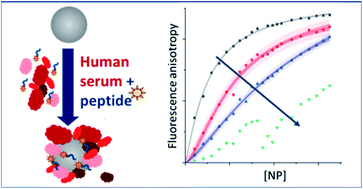The role of human serum and solution chemistry in fibrinogen peptide–nanoparticle interactions†
Abstract
In living systems, the biomolecules that coat nanoparticles (NPs) alter the NP biological identity and response. Although some biomolecules are more effective in mediating NP stability or biological fate, it is difficult to monitor an individual biomolecule within the complexity of the biota. To understand the dependence of protein–NP interactions on common variations in blood, we have evaluated binding between silica NPs and a model gamma-fibrinogen (GF) peptide. Fibrinogen is commonly identified within the protein corona fingerprint of human serum, but its abundance on the NP varies. To assess the relative importance of human serum and solution conditions, GF peptide and silica NP interactions were evaluated with and without serum across various pH, NaCl concentrations, and glucose concentrations. Initial evaluation of the GF peptide and silica NP complexes using circular dichroism and dynamic light scattering show little change in the secondary structure of the peptide and no significant agglomeration of NPs, suggesting peptide–NP complexes are stable across study conditions. Fluorescence anisotropy was used to monitor GF peptide–NP binding. Both with and without serum, binding constants for the gamma-fibrinogen peptide vary significantly upon addition of diluted HS (1 : 500) and 29 mM sodium chloride. Yet, results indicated that gamma-fibrinogen binding interactions with silica NPs are comparatively insensitive to physiologically relevant pH changes and dramatic increases in glucose concentrations. Results highlight the importance of blood chemistries, which vary across individuals and disease states, in mediating protein corona formation.



 Please wait while we load your content...
Please wait while we load your content...